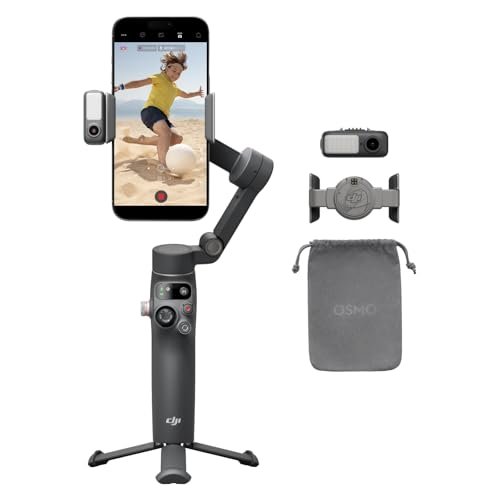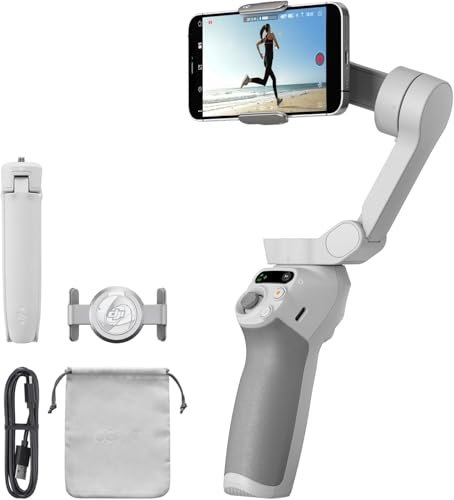Ever tried shooting a video with your smartphone, only to find it looks like you’re filming during an earthquake? Shaky footage is a common problem, but thankfully, there’s a simple solution: a gimbal. These clever devices stabilize your camera, turning wobbly clips into smooth, professional-looking video. And guess what? You don’t need to break the bank to get one. Finding the best gimbal for around $150 is totally doable if you know what to look for.
In this article, we’re diving deep into an excellent option that offers fantastic value, helping you elevate your mobile videography without emptying your wallet. Get ready to discover how to achieve buttery-smooth footage every time!
Why You Need a Gimbal for Your Smartphone Videos
Smartphones are incredible for video recording these days, boasting high-resolution cameras and advanced features. However, they still struggle with stability, especially when you’re moving. That’s where a smartphone gimbal steps in. A good gimbal provides mechanical stabilization, counteracting your movements to keep your phone level and steady. This means:
- Professional-looking footage: No more distracting jitters.
- Smoother pans and tilts: Cinematic motion that’s a joy to watch.
- Better low-light performance: Less blur from camera shake.
- Enhanced creative options: Features like Dolly Zoom or Sport Mode open up new possibilities.
For content creators, travelers, or just anyone who loves capturing life’s moments, an affordable gimbal can be a game-changer. Let’s explore our top recommendation that perfectly fits the $150 budget.
The Go-To Budget Stabilizer

If you’re hunting for the best gimbal for around $150 that truly delivers, “The Go-To Budget Stabilizer” stands out as a prime contender. This compact and intuitive device is specifically designed for smartphone users who want to step up their video game without a steep learning curve or a hefty price tag. It’s built with portability in mind, easily foldable to slip into a backpack or even a larger pocket, making it an ideal companion for spontaneous shoots, travel vlogging, or just capturing everyday moments with cinematic flair. Its robust motor system ensures your footage stays incredibly stable, whether you’re walking, running, or trying out dynamic camera movements.
Key Features:
– 3-Axis Stabilization: Provides superior stabilization across tilt, roll, and pan axes, eliminating shaky footage.
– Foldable & Portable Design: Compact when folded, making it super easy to carry everywhere.
– Intuitive Controls: User-friendly buttons and a joystick for effortless operation and precise camera control.
– Intelligent Tracking: Advanced active tracking features ensure your subject stays in focus and framed, even if they’re moving.
– Quick Mount System: Allows for fast phone attachment and detachment, so you never miss a shot.
– Extended Battery Life: Offers several hours of continuous operation on a single charge, perfect for long shooting sessions.
Pros:
– Excellent value for money, delivering premium features at a budget price.
– Remarkably effective stabilization, producing very smooth footage.
– Lightweight and easy to transport, ideal for on-the-go content creation.
– Simple setup and user interface, great for beginners.
– Companion app enhances functionality with creative modes like Dolly Zoom and Hyperlapse.
Cons:
– Build quality, while good for the price, might not feel as premium as much more expensive gimbals.
– Some advanced features might require a bit of practice to master.
– Limited payload capacity means it’s strictly for smartphones, not heavier cameras.
User Impressions:
Users consistently praise this gimbal for its incredible ease of use and the immediate improvement it brings to their video quality. Many are genuinely surprised by how much stability they get for the price, often stating it’s “the best bang for your buck.” The active tracking feature is a particular highlight, making solo vlogging or filming pets/kids much simpler. While a few noted that the companion app occasionally has minor glitches (which are often fixed with updates), the overall sentiment is overwhelmingly positive, with users recommending it as an excellent entry-level stabilizer for anyone serious about mobile videography.
What to Look For in a Gimbal Under $150
When you’re shopping for a gimbal on a budget, it’s essential to prioritize what truly matters. Here are a few key aspects to consider:
- Stabilization: Look for 3-axis stabilization. This is crucial for truly smooth footage.
- Portability: Is it foldable? Lightweight? Will it fit easily into your bag?
- Ease of Use: A simple setup process and intuitive controls are vital, especially for beginners.
- Battery Life: You don’t want your gimbal dying in the middle of a shoot. Check for at least 6-8 hours of operation.
- App Features: Many gimbals come with companion apps that offer advanced features like object tracking, time-lapse, and panorama modes.
- Build Quality: While you’re on a budget, you still want something that feels durable enough for regular use.
Frequently Asked Questions (FAQ)
Q1: What exactly is a gimbal and how does it work?
A: A gimbal is a device that uses motors and sensors to stabilize a camera or smartphone along multiple axes (typically 2 or 3). It detects unwanted movements like shakes and tilts, then automatically counteracts them, keeping your device perfectly level and your footage silky smooth.
Q2: Do I really need a gimbal if my phone has optical image stabilization (OIS)?
A: While OIS helps reduce minor shakes, a dedicated gimbal offers mechanical stabilization that is far superior. OIS corrects small jitters, but a gimbal can handle larger movements like walking, running, or even dynamic pans, resulting in truly cinematic and professional-looking footage that OIS alone can’t achieve.
Q3: Is a $150 gimbal good enough for professional-looking videos?
A: Absolutely! For many types of content, especially online videos, vlogs, and social media clips, a well-chosen gimbal for around $150 can make a massive difference. While high-end gimbals offer more features and heavier payload capacities, a good budget option provides the essential smooth footage needed for a polished, professional look.
Q4: Can I use any smartphone with a budget gimbal?
A: Most gimbals are designed to accommodate a wide range of smartphone sizes and weights. However, it’s always wise to check the gimbal’s specific compatibility (e.g., max payload, clamp width) with your phone model, especially if you have a very large or heavy phone.
Q5: Are gimbals difficult to set up and use for beginners?
A: Not at all! Modern gimbals, especially the popular entry-level models, are designed with user-friendliness in mind. Many offer quick-release systems for easy mounting and have intuitive controls. Plus, companion apps often provide tutorials and simplified modes to help you get started quickly.
Q6: What’s the difference between a 2-axis and a 3-axis gimbal?
A: A 2-axis gimbal stabilizes your camera on two axes, typically tilt and roll, compensating for up-and-down and side-to-side movements. A 3-axis gimbal adds stabilization on the pan axis, allowing for smooth left-to-right rotation. For the smoothest and most versatile footage, a 3-axis gimbal is highly recommended and standard even in budget options these days.
Q7: How important is battery life for a gimbal?
A: Very important! A longer battery life means you can shoot for extended periods without worrying about recharging. Look for gimbals that offer at least 6-8 hours of operation on a single charge. This is usually sufficient for a day’s worth of casual shooting or even a dedicated content creation session.
Final Thoughts
Investing in the best gimbal for around $150 is one of the smartest decisions you can make to dramatically improve your mobile video quality. You don’t need to splurge to get fantastic results. Our top pick, “The Go-To Budget Stabilizer,” exemplifies how affordability can meet performance, offering a robust solution for achieving that coveted cinematic look. So, go ahead, stabilize your shots, unleash your creativity, and make every video a masterpiece!


